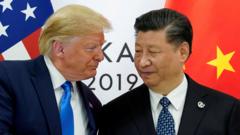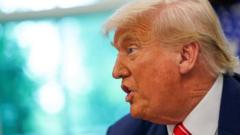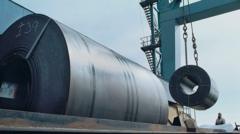In a significant policy shift, President Trump's administration has doubled import tariffs on steel and aluminum, now standing at 50%. The decision, aimed at boosting U.S. industries, has drawn criticism from key allies and concern from various sectors reliant on these materials.
U.S. Increases Tariffs on Steel and Aluminum to 50%

U.S. Increases Tariffs on Steel and Aluminum to 50%
The new tariffs come as President Trump intensifies efforts to support domestic metal industries amid rising competition from foreign imports.
The United States has officially implemented a drastic increase in tariffs on steel and aluminum imports, raising the rate to 50%. This change follows President Trump’s continued efforts to protect domestic industries against foreign competition, justifying the tariffs as essential for national security.
The tariffs, which have escalated from a previous rate of 25%, were announced during a presidential visit to a U.S. Steel mill, with the administration highlighting the need to counteract what it describes as unfair trade practices. This move comes as part of a larger strategy to support steelworkers and industries in critical states such as Pennsylvania.
The escalation in tariffs has not been well received by some of America’s closest trading partners, including Canada and several European nations, who rely on exporting metals to the U.S. The significant increase in cost is expected to affect numerous industries that depend on steel and aluminum, ranging from automotive to construction.
In response to the announcement, Kevin Dempsey, president of the American Iron and Steel Institute, voiced strong support, noting that the ongoing overproduction of steel and aluminum by countries like China is detrimental to American producers. Dempsey contended that these tariffs would aid in preventing further import surges that could harm domestic steel production and employment.
As the situation develops, stakeholders from various sectors will be closely monitoring the impacts of these higher tariffs and how they might reshape the landscape of international trade relations.
The tariffs, which have escalated from a previous rate of 25%, were announced during a presidential visit to a U.S. Steel mill, with the administration highlighting the need to counteract what it describes as unfair trade practices. This move comes as part of a larger strategy to support steelworkers and industries in critical states such as Pennsylvania.
The escalation in tariffs has not been well received by some of America’s closest trading partners, including Canada and several European nations, who rely on exporting metals to the U.S. The significant increase in cost is expected to affect numerous industries that depend on steel and aluminum, ranging from automotive to construction.
In response to the announcement, Kevin Dempsey, president of the American Iron and Steel Institute, voiced strong support, noting that the ongoing overproduction of steel and aluminum by countries like China is detrimental to American producers. Dempsey contended that these tariffs would aid in preventing further import surges that could harm domestic steel production and employment.
As the situation develops, stakeholders from various sectors will be closely monitoring the impacts of these higher tariffs and how they might reshape the landscape of international trade relations.





















